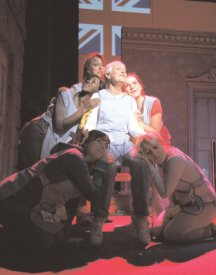
Jim Tough provides a sector-wide review of how the Scottish Arts Council has been supporting the arts, and heralds the future of artistic activity in Scotand.
In January 2005, the Scottish Arts Council (SAC) began a strategic review of its funding and relationships across the wider arts sector. Our intention was to make the best use of the funds available to us by ensuring that high achieving organisations were fully supported and that we could respond to new initiatives as they arose.
From the outset
When we began our review, we were providing revenue funding to more than 110 core-funded organisations, including the major national performing companies. The government-sponsored Cultural Commission had recently reported, with over 139 recommendations, and the then Minister indicated her intention to transfer responsibility for the national companies directly to the Scottish Government. In addition, our forecast Lottery income was due to fall by £5m over the following years.
The strategic review began with an assessment of what each sector across visual arts, drama, dance, music, etc. needed to help it thrive. We knew that some organisations needed advice and support more than hard cash.
New investments
The strategic review also threw into sharp relief the extent of our relationship with the creative industries: our experience in supporting publishing, scriptwriting and our central role in the recently launched Scottish Music Industry Association. Our investment is not aimed at simply achieving a profit, but is recognition that without support at the grass roots, there is no creative industry. The then Culture Minister responded to our call for a strengthened and sustainable cultural sector by granting us additional funding of £7m, an increase of over 10% on our baseline funding. One of the main outcomes was the development of new priorities in our work between 2007 and 2009.
The next outcome of the review was the creation of 48 Foundation organisations. Organisations recognised for their reach, role and national impact, that support artists, develop audiences and who offer the widest possible opportunities to learn about their work, were given substantial increases.
Weve created new types of investment; flexible to support great artistic teams and project to support one-off ideas. Flexible support is finite and not a life-term commitment. This recognises that some of the best artistic teams come together to realise an idea together, but may eventually go their separate ways. Project support allows a leg-up to emerging ideas or organisations. It is investment in risk, or new work, or new ways of achieving ambitions. Whereas previously more than 85% of direct government funding was immediately committed, this has reduced to 72%, increasing our opportunities to respond to changing dynamics within the sector.
Supporting the sectors
The dance sector has been a significant beneficiary of the additional investment. For dance in Scotland to achieve its potential, it requires high quality choreography and to achieve this we need to invest in the development of practice and the environment and circumstances that will enable this.
We have been able to look again at our commitments to supporting choreographers and companies. We were able to invite artist-led companies to submit two-year proposals and, from April 2007, Plan B, Stammer Productions and X-Factor Dance Company were supported to realise ambitious artistic programmes of work.
Crafts in Scotland have secured an internationally renowned centre, Northlands Glass, as a Foundation organisation. A programme of development will increase the opportunities that audiences have to experience new work for themselves. We have also increased our support for individual writers by doubling our investment in professional development, increasing support for Literature Development Workers and supporting writers working in a variety of settings. Visual artists will benefit from an increased number and range of opportunities at all stages of their career. Thirteen foundation organisations, extending from galleries in the Scottish islands to flagship galleries in Scotlands major cities, will create and present work of the highest quality.
Development of music now encompasses traditional music, jazz, chamber music and the contemporary music sector. We are also introducing audiences to more new music through our touring programme, Tune Up. A £1m performing arts programming fund was created to support promoters, festivals and venues of all scales across the country to programme theatre, dance and music.
Success stories in drama include Dundee Rep; an increase in grant has enabled the large-scale production of Sunshine on Leith that played to sell-out performances across Scotland. Individuals can now apply for new work funds, which will nurture emerging professionals. Glasgows Arches received an increase to allow it to expand its two theatre festivals, including the presentation of international work. Theatre Workshops increased funding supports touring opportunities for disabled artists and sustains the bi-annual Degenerate Festival which showcases work by disabled artists.
Participation in the arts remains a core part of our work and includes broadening attendance at arts events, galleries and performances, maximising the sale of arts and crafts, and encouraging organisations to adopt a philosophy and practice which could range from targeting under-represented groups, to deepening an individual audience members confidence with the artistic programme.
Looking forward
We know theres still much to be done. In the coming year, we will be revisiting our international strategy, particularly showcasing, to ensure that Scottish artists are presenting their work to the most influential international audiences. We have significantly increased our investment in our Equalities work, supporting work for and by disabled artists, culturally diverse organisations and work within the arts and health sector.
Within coming months we will unveil our new strategy to support and increase participation levels in the arts, and by so doing transform the lives of many who may have had few opportunities to experience the arts previously. Within these changes is the recognition that SAC is going through its own metamorphosis. The Scottish Government has confirmed that a new organisation, Creative Scotland, will be established within the next 18 months. This will see investment and development for the screen sector, arts and cultural policy, and the creative industries housed under one roof, to the benefit of all who rely on the confidence of public investment to realise their creative ambitions.

Jim Tough is Acting Chief Executive of the Scottish Arts Council. t: 0131 226 6051;
w: http://www.scottisharts.org.uk



